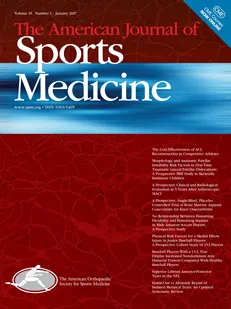Long-term Results After Arthroscopic Repair of Isolated Subscapularis Tears
Background: Although some reports have presented short- to midterm results after arthroscopic repair of isolated subscapularis (SSC) tendon tears, long-term evaluation is still lacking.
Hypothesis: Long-term results after arthroscopic repair of isolated SSC tears are comparable with the functional and radiological short- to midterm outcomes described in the literature.
Study Design: Case series, Level of evidence, 4.
Methods: This study assessed 17 patients (5 females and 12 males; mean age, 45.6 years) with isolated SSC tears (Fox and Romeo classification types 2-4) who underwent all-arthroscopic suture anchor repair. The mean interval from symptom onset to the time of surgery was 5.3 months in 16 patients (94.1%). One patient (5.9%) was symptomatic for a prolonged period (104 months) before surgery. All patients were assessed with a clinical examination preoperatively. SSC function was investigated using specific clinical tests and common scoring systems, including Constant, American Shoulder and Elbow Surgeons (ASES), Disabilities of the Arm, Shoulder and Hand (DASH), and Simple Shoulder Test (SST) scores. At follow-up, muscular strength was evaluated using an electronic force-measuring plate. Structural integrity of the repair was assessed using magnetic resonance imaging (MRI).
Results: At a mean follow-up of 98.4 ± 19.9 months, the mean Constant score improved from 47.8 preoperatively to 74.2 postoperatively (P = .001). Higher Constant (P = .010) and ASES (P = .001) scores were significantly associated with a shorter time from symptom onset to surgery. The size of the SSC lesion did not correlate with any clinical score outcome (P = .476, .449, .985, and .823 for Constant, ASES, DASH, and SST scores, respectively). Three patients (17.6%) had persistent positive clinical test results (belly-press/lift-off). Compared with the uninjured contralateral side, SSC strength was significantly reduced in the belly-press position (P = .031), although active internal (P = .085) and external (P = .093) rotation was not affected. In 1 patient, a rerupture was detected by MRI. Six patients had cranial SSC atrophy. Overall, 88.2% of patients were “very satisfied” or “satisfied” with their results.
Conclusion: Arthroscopic repair of isolated SSC tears results in significant clinical improvements and enduring tendon integrity, although SSC strength remains reduced in the long term. Early surgical treatment seems to be a relevant factor allowing good shoulder function.
